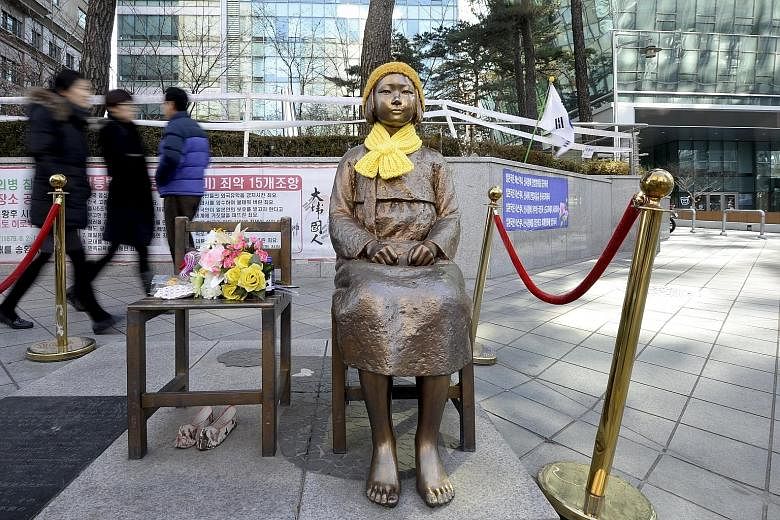SEOUL • One test of the commitment by Japan and South Korea to resolve the "comfort women" issue may be the fate of a statue in front of Tokyo's embassy in Seoul.
The bronze of a barefoot teenage girl in a traditional hanbok dress, sitting on a chair with fists clenched on her lap and an empty chair beside her, has become a symbol of "comfort women", as those who were forced to work at Japan's wartime military brothels are known.
For many Japanese officials, the presence of the 1.5m-tall statue in front of the embassy is a symbol of South Korea's unwillingness to lay the issue to rest, as well as an affront to its national dignity that should not be permitted by Seoul.
-
Emotive issue of wartime sex slaves
-
TOKYO • The emotive and complex issue of wartime sex slaves - euphemistically known as "comfort women" - has long soured relations between Japan and South Korea.
Q Who are the "comfort women"?
A They were women and young girls mostly from the Korean peninsula, China, the Philippines and what is now Indonesia taken to former Japanese military installations and forced to provide sexual services to officers and soldiers during World War II.
Up to 200,000 women are believed to have been sexually enslaved by Japan during the war. Few are alive 70 years after the end of the war, with the number in South Korea at 46.
Q Why is the issue important?
A It has long stood in the way of better relations between Japan and neighbouring countries, particularly South Korea and China. It has also proved to be a diplomatic headache for the United States, which is seeking to strengthen security cooperation between Tokyo and Seoul, Washington's key Asian security allies.
Q How was an agreement finally reached?
A Japanese Prime Minister Shinzo Abe and South Korean President Park Geun Hye called for a resolution of the issue at a summit last month in Seoul. There have since been a series of meetings between senior diplomats of the two countries up until Sunday, culminating in the meeting between their foreign ministers yesterday in Seoul. US pressure on both countries to try to put their differences behind them and an apparent shift in public opinion in South Korea, with some media expressing concern over worsening ties with Japan, are seen as factors.
-
AGENCE FRANCE-PRESSE
"It is not something that friendly nations normally do," said a former Japanese diplomat with experience in East Asia, asking not to be identified.
"Every Wednesday, they have gatherings there protesting on the question of comfort women, in front of the embassy, and that reminds everyone, and that is not good," the former diplomat told Reuters.
In the agreement yesterday to resolve the comfort-women issue, South Korea did not agree to remove the statue, but Foreign Minister Yun Byung Se said Seoul recognises Japan's concerns and will hold discussions with the group that erected it to address the problem.
But it will take an act of political courage in Seoul to relocate the statue, which has served as a potent symbol of Japanese wartime aggression.
Yesterday, the statue had a yellow woollen scarf around the neck and a brown cap on its head. The empty chair next to it symbolises fellow victims who have died, said sculptor Kim Seo Kyung, who built the statue with her husband.
The group behind the statue, the Korean Council for the Women Drafted for Military Sexual Slavery by Japan, rejected Mr Yun's comments as "disgraceful" and "appalling".
REUTERS

